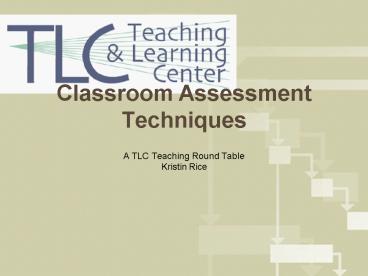A TLC Teaching Round Table - PowerPoint PPT Presentation
1 / 26
Title:
A TLC Teaching Round Table
Description:
Pros & Cons (this can be done as a CAT also!!) Classroom Opinion Poll % used CATs ... could this CAT be used in a class? 14. Types of CATs. Course-Related ... – PowerPoint PPT presentation
Number of Views:95
Avg rating:3.0/5.0
Title: A TLC Teaching Round Table
1
Classroom Assessment Techniques
- A TLC Teaching Round Table
- Kristin Rice
2
Classroom Assessment Techniques (CATs)
- Welcome!
- Please begin filling out the Goal Ranking and
Matching Form. - Please take 2 index cards.
- When the manila envelope reaches you, please
answer the question on the envelope on one index
card and place it in the envelope. Then pass the
envelope on
3
The Typical CAT
- Explained ahead of time
- Implemented anonymously in one class session
- Discussed in the next
- But, during this session
4
Objectives
- Definition
- Uses
- Experience
- Sharing
- Resources
5
Classroom Assessment Techniques
- "Classroom Assessment is a simple method faculty
can use to collect feedback, early and often, on
how well their students are learning what they
are being taught. The purpose of classroom
assessment is to provide faculty and students
with information and insights needed to improve
teaching effectiveness and learning quality.
Angelo, T.A., 1991
6
Discussion 1
- Please pass in your Goal Ranking and Matching
Sheets. - Introduce yourself to a neighbor
- What do you teach?
- Have you ever used CATs?
7
Report Back
- Goals Ranking Summary
- Will I cover all goals?
- What goals are not covered?
- When would this be a useful CAT?
8
Characteristics of CATs
- Learner Centered
- Teacher-Directed
- Mutually Beneficial
- Formative
- Context-Specific
- Ongoing
- Rooted in Good Teaching Practice
- Typically Anonymous
9
Why Use CATS
- Faculty Benefits
- Provide insight into day-to-day learning
- Formative changes can be made
- Variable time commitment
- Foster good rapport
- Teaching and learning evolve over time
10
Why Use CATS
- Student Benefits
- Monitor own learning
- Point out need to alter study skills
- Make large classes smaller
- Show that instructors care about learning
11
Classroom Opinion Poll
- On one index card, please answer the following
- Have you ever used CATs?
- If so, what type?
- Please pass your index card to the front.
12
Discussion 2
- Introduce yourself to a new person
- What do you teach?
- In what kinds of CATs are you interested?
- What do you see as the Pros and Cons of CATs?
13
Report Back
- Pros Cons (this can be done as a CAT also!!)
- Classroom Opinion Poll
- used CATs
- Types used
- How could this CAT be used in a class?
14
Types of CATs
- Course-Related Knowledge and Skills
- Learner Attitudes, Values and Self-Awareness
- Learning Reactions to Instruction
15
Knowledge Skills
- Minute Paper
- Muddiest Point
- One-Sentence Summary
- Pro-Con Grid
- Whats the Principle
- Student-Generated Test Questions
- Clickers
16
Attitudes, Values Self-Awareness
- Classroom Opinion Polls
- Goal Ranking and Matching
- Process Analysis
17
Learning Reactions to Instruction aka
Mid-Course Evaluations
- Chain Notes
- Group Work Evaluations
- Student Assessment of Learning Gains (SALGs)
- Free Assessment Summary Tool (FAST)
18
Discussion 3
- With your neighbors
- Do you think you will use CATs in your classes?
- Why or why not?
19
Report Back
- Chain Note Summary
- What are people thinking?
- How can this be used in a class?
20
First Steps
- Check resources for ideas, suggestions, examples,
uses, etc. - Choose a CAT that fits your needs and your
available time - Choose a class you know well to minimize risks
- Determine a class time to use a CAT
21
Implementation
- Explain intentions to students
- Clearly explain CAT procedure
- Perform CAT and collect responses
22
Close the Loop
- Same class or next class
- Sort and analyze responses
- Provide tallies/summaries of responses
- Determine and announce course adjustments if
needed - Give suggestions or ask class to brain-storm
suggestions regarding student learning
23
CAT Suggestions
- COMFORT If a CAT does not appeal to you do not
use it. - EASE Dont make CATs a self-inflicted chore or
burden. - PROVEN Dont ask your student to use any CATs
you havent previously tried on yourself. - TIME Allow for more time than you think you
will need to carry out and respond to the
assessment. - RESPOND Make sure to close the loop. Let
students know what you learn from their feedback
and how you and they can use that information to
improve learning.
24
Muddiest Point
- On one index card, please answer the following
- 1. What has been the "muddiest" point so far in
this session? That is, what topic remains the
least clear to you? - Please pass your index card to the front.
25
Resources
- TLC Library
- On-line
- CLOC
26
Report Back Questions
- Muddiest Point Summary
- Muddy areas
- Questions































